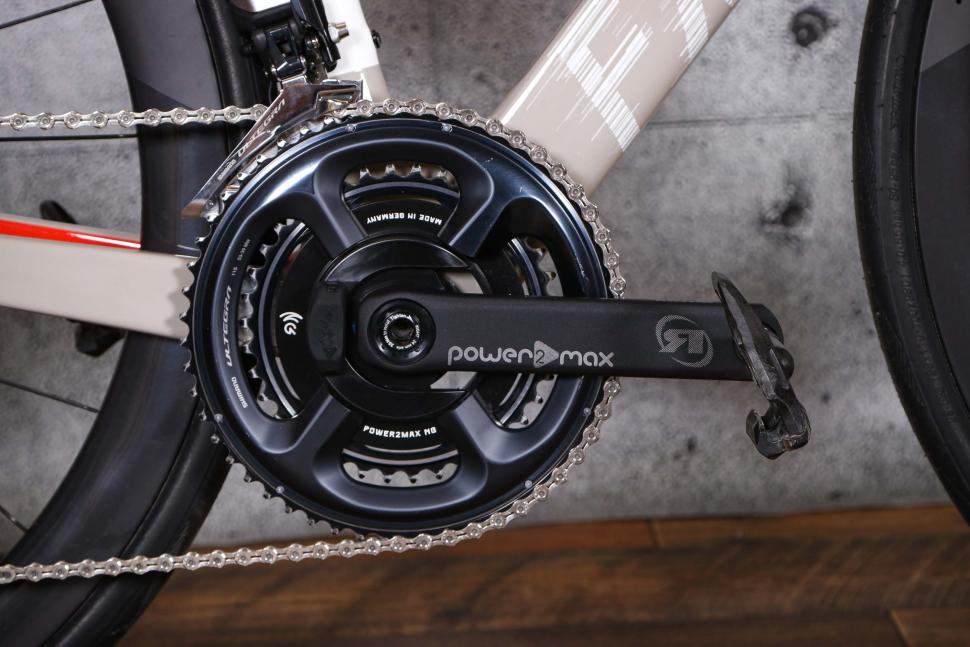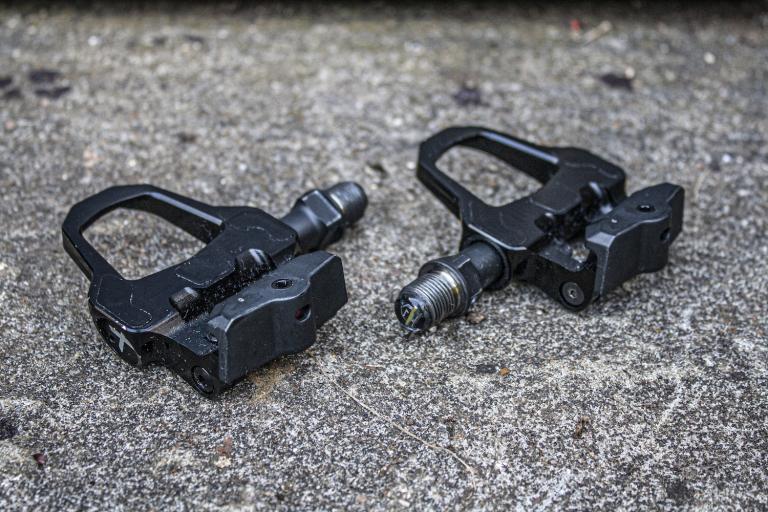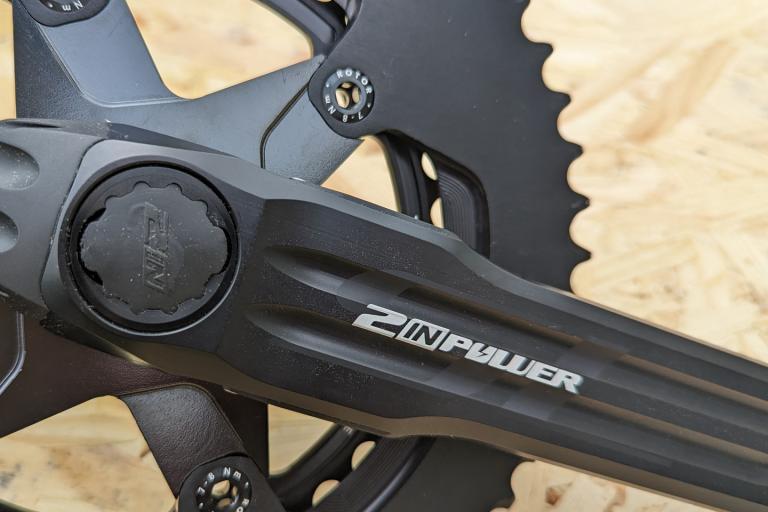- News
- Reviews
- Bikes
- Accessories
- Accessories - misc
- Computer mounts
- Bags
- Bar ends
- Bike bags & cases
- Bottle cages
- Bottles
- Cameras
- Car racks
- Child seats
- Computers
- Glasses
- GPS units
- Helmets
- Lights - front
- Lights - rear
- Lights - sets
- Locks
- Mirrors
- Mudguards
- Racks
- Pumps & CO2 inflators
- Puncture kits
- Reflectives
- Smart watches
- Stands and racks
- Trailers
- Clothing
- Components
- Bar tape & grips
- Bottom brackets
- Brake & gear cables
- Brake & STI levers
- Brake pads & spares
- Brakes
- Cassettes & freewheels
- Chains
- Chainsets & chainrings
- Derailleurs - front
- Derailleurs - rear
- Forks
- Gear levers & shifters
- Groupsets
- Handlebars & extensions
- Headsets
- Hubs
- Inner tubes
- Pedals
- Quick releases & skewers
- Saddles
- Seatposts
- Stems
- Wheels
- Tyres
- Health, fitness and nutrition
- Tools and workshop
- Miscellaneous
- Tubeless valves
- Buyers Guides
- Features
- Forum
- Recommends
- Podcast
review
 Power2Max NGeco power meter
Power2Max NGeco power meter£551.34
VERDICT:
Accurate, reliable and very well built, but expensive for UK buyers
Accurate spider-based data
Reliable
Well built
Cheapest spider-based power meter
More involved to switch between bikes than others
Heavier than a single-sided setup
Weight:
693g
Contact:
At road.cc every product is thoroughly tested for as long as it takes to get a proper insight into how well it works. Our reviewers are experienced cyclists that we trust to be objective. While we strive to ensure that opinions expressed are backed up by facts, reviews are by their nature an informed opinion, not a definitive verdict. We don't intentionally try to break anything (except locks) but we do try to look for weak points in any design. The overall score is not just an average of the other scores: it reflects both a product's function and value – with value determined by how a product compares with items of similar spec, quality, and price.
What the road.cc scores meanGood scores are more common than bad, because fortunately good products are more common than bad.
- Exceptional
- Excellent
- Very Good
- Good
- Quite good
- Average
- Not so good
- Poor
- Bad
- Appalling
The Power2Max NGeco is one of the best power meters on the market for a bike that is going to see a lot of dirty miles. It boasts accurate data, top-notch reliability and a design that is bombproof. Compared to a single-sided unit, however, it is a bit weighty, and the price is higher than its main rival thanks to import costs.
Testing any cycling product usually means getting as many miles in as possible during a month and then submitting the words. But thanks to various poor excuses (sorry Tass!), I've managed to clock well over 10,000km on the NGeco. It's gone through plenty of rain thanks to time on my winter bike, I've raced it on the road, and I've even subjected it to some cyclocross action.
> Buy now: Power2Max NGeco for £552 from Power2Max
The NGeco has performed flawlessly the entire time, cementing this in my mind as the best choice on the market for a bike that is going to see year-round use.
But there are a few caveats to that, and my glowing opening doesn't mean this is necessarily going to be the power meter for you. It might be best if we start with the basics and look at what we actually have here.
What is it?
The Power2Max NG Eco is a spider-based power meter, the spider being the bit between the cranks and the chainrings. The unit alone is priced at €540. If you're already using Easton, FSA, Praxis Works, SRAM or Rotor cranks then you're probably not going to need to replace these too. But users of a Shimano crank will need to buy the NGeco with a Power2Max crank, pushing the price up by €100. This is what happened in my case, and I was then able to fit my standard Shimano chainrings.
While we're here, the BCD (bolt circle diameter) of the NGeco, in the four-bolt Shimano model, is 110mm, so any 11 or 12-speed Shimano chainring will fit.
The NGeco is the baby brother of the NG, a spider-based power meter offering dual-sided power data. The NGeco captures power data from both cranks, too, but unlike its big brother it doesn't give you power balance figures. You can unlock these, along with some other features, but you'd be paying a not-small surcharge, so it isn't something I'd be bothering with.
> 12 reasons why you should buy, and use, a power meter
The weight, if you're building a weight weenie bike, is going to be one potential issue. The 170mm cranks and spider that we have here weigh 693g. Taking the chainrings off the standard Ultegra cranks that the NGeco replaced, the cranks and spider weigh 565g, so we're looking at a decent bit of weight (around 130g) being added to the bike. Certainly, if you want a lightweight build, a single-sided power meter from 4iiii, Stages and the like would be a better bet.
Installation
The installation was a relatively easy process, though certainly more tricky than the 4iiii G3 that I reviewed.
The good news is that when the NGeco is on the bike, the calibration process is the easiest I've come across. You don't need to put the crank in a particular position, uou just hit calibrate on your head unit.
Switching this between bikes would be a bit too long a process for me to want to do it regularly, but it wasn't too much of an issue when I needed to pop it onto a new frame.
In use
Once out riding, I really liked having my trusted Shimano chainrings providing their usual shift quality.
Spider-based power meters are generally touted as being highly accurate units and the NGeco is perfect in this department. I'm not usually one to dive too deeply into comparing power meters, but here are some graphs where I tested the NGeco against a Tacx Neo 2T running the latest software. Ignore what look like dropouts – that's me hopping off to stretch or grab the TV remote.
The overall picture is very good. We have nothing to worry about here, with a close average power and the NGeco tracks the Neo 2T nicely.
Diving a bit deeper into one of my pitiful efforts, we can see that the NGeco reads slightly higher than the Neo 2T. There is a little separation at the 260W intervals, but we're talking about a spider-based unit versus a trainer, so it is very possible that those 3ish watts are being lost through the chain that I should have replaced at the end of last winter.
The real test, however, has been the hours that I've spent ticking through the miles of training and racing. I've had zero issues with this unit, seeing no spikes that might throw off my yearly figures or power records. If you're looking for accurate and reliable data at a respectable price, this really does provide.
Value & conclusion
Speaking of money, Power2Max is based in Germany and does not currently have a UK distributor, so you're going to get stung by some lovely import VAT. It takes the cost to around £670 for the unit we have here, which is a rather hefty price to pay.
The Quarq DFour is likely to be the main rival to the NGeco. With Quarq cranks and a 24mm axle to match the NGeco setup we have, you'd be paying £573. For customers in the UK, I just can't see the extra £120 or so being worth paying.
It is a brilliant option if you want accurate and reliable power data taken from both cranks, but it is heavy compared with a single-sided setup, and thanks to Brexit, UK customers would be able to save around £120 by going for the Quarq DFour.
Verdict
Accurate, reliable and very well built, but expensive for UK buyers
road.cc test report
Make and model: Power2Max NGeco power meter
Size tested: 110 4-S / 170mm
Tell us what the product is for and who it's aimed at. What do the manufacturers say about it? How does that compare to your own feelings about it?
From Power2Max:
"The NGeco Rotor power2max-Edition Set consists of our NGeco power meter to measure the combined power of both legs and a new Rotor direct mount crankset in the exclusive power2max design.
The aluminium crankset is forged and hollow-bored and weighs only 693g including the power meter. Its 24mm steel axle allows it to replace all current Shimano cranksets without using any special tools. Due to customer demand, the set was developed for the Shimano Hollowtech II bottom bracket standard and combines superior stiffness with an excellent price-performance ratio.
If you want to continue using your Shimano Dura-Ace, Ultegra or 105 4-arm chainrings you can choose our 110 4-S or 110 4-SL version. This setup allows you to keep the optimal shifting performance. Additionally, the 110 4-SL saves 30g of weight compared to the 110 4-S for an additional cost of 100€ (incl. VAT)."
Tell us some more about the technical aspects of the product?
From Power2Max:
BCD IN MM: 110, 130, 110 4-S
WEIGHT POWER METER: 110: 157g, 130: 168g, 110-4S: 158g, 110-4SL: 125g
WEIGHT POWER METER WITH CRANKS: 110: 693g, 130: 704g, 110-4S: 694g
CHAIN LINE: 43,5 mm
Q-FACTOR: 148 mm
CRANK AXLE DIAMETER MM: 24
CRANK LENGTH IN MM: 165, 170, 172.5, 175
Rate the product for quality of construction:
10/10
Rate the product for performance:
10/10
Rate the product for durability:
10/10
Rate the product for weight (if applicable)
5/10
Rate the product for value:
4/10
Tell us how the product performed overall when used for its designed purpose
Perfectly. It allows you to track your progress accurately and with confidence.
Tell us what you particularly liked about the product
Properly accurate and reliable data. That is the sole function of a power meter.
Tell us what you particularly disliked about the product
The import costs.
How does the price compare to that of similar products in the market, including ones recently tested on road.cc?
It is, on paper, very similar to the Quarq DFour. But importing one from Germany is going to add about £120.
Did you enjoy using the product? Yes
Would you consider buying the product? Yes
Would you recommend the product to a friend? In a heartbeat.
Use this box to explain your overall score
Consistent data is what I want from a power meter because that allows you to train confidently. That's what you get here, backed up by the fact that it is kicking out data in line with the Tacx Neo 2T. I've had no issues with reliability in over 10,000km of riding. The only annoying thing is that, because it is coming from Germany, you're paying extra fees over something like the Quarq DFour.
About the tester
Age: 27
I usually ride: Specialized S-Works Tarmac SL7 My best bike is:
I've been riding for: Under 5 years I ride: Most days I would class myself as: Expert
I regularly do the following types of riding: road racing, time trialling, cyclo cross, commuting, club rides, general fitness riding, I specialise in the Cafe Ride!
Latest Comments
- 53.12.scruz 1 hour 18 min ago
I just saw a weight for this bike on a retailer's web site. 9kg for the Ultegra build. If that's not an error, it's shocking and beyond off...
- David9694 2 hours 2 min ago
17 minutes, you say, gosh say public transport users, how terrible for you. ...
- brooksby 2 hours 14 min ago
Who's looking after your bridge while you're posting on here?
- open_roads 2 hours 17 min ago
Horse. Stable Door. bolted.
- Simon E 3 hours 8 min ago
Rather more than a Boardman SLR 8.6 at £650 with Claris. Cycling UK members will probably get a discount off that price....
- tubasti 3 hours 37 min ago
With the wattage these guys are generating on their downstrokes, their lack of mass above the hips, the low gearing they're using to get up the...
- IanEdward 3 hours 55 min ago
Mixed first impressions from me. Applied to a previously waxed Ultegra chain which had first been washed almost clean on a very wet gravel ride,...
- Simon E 4 hours 8 min ago
I just saw the word 'smart' and instantly thought "No. It really isn't". (as is invariably the case with any item that is prefixed 'smart')....
- Simon E 4 hours 15 min ago
That is a fascinating discussion, thanks....








Add new comment
3 comments
be aware, the battery cover on this model is pretty poor. it leaks, and the retention clips break with minimal provocation.
I've got the NGEco on my gravel bike (cervelo aspero) - that's taken a hell of a beating over the past 18 months, both through on and off road riding and non-too careful washing - and I've not had a single problem with the power meter or its battery cover. Initially I was worried that it wouldn't last, so I got them to send a couple of spares, but no need for them so far.
I wonder if its a case of me having very good luck or you having very bad?
@liam Running those already for 10 years since type s combined with rotor cranks. Most powermeters perform well indoor but fail outside to be consistent. Check dc rainmaker and gplama. Srm pedals fail, shimano fail, rotor fails, all with unexplained quirks. Srm the so called gold standard had only recently temp compensation. A full aldhu crank 30mm with carbon arms and power2max ng 4sl I run now is only 620gr for 1/3 of an uberexpensive srm setup. Its cheaper then a shimano dura ace crank with powermeter and above all 50gr lighter then a stock dura ace crank without powermeter. And at least is 100% reliable and doesn't overread. If rotor would bond the arms to the shaft it would rival the lightest setups at the expense of modularity. Its my 3 versions now on 3 bikes (type s,ngeco and ng). I have no reason in all those years to switch to anything else it just runs and runs consistenly between all of them.